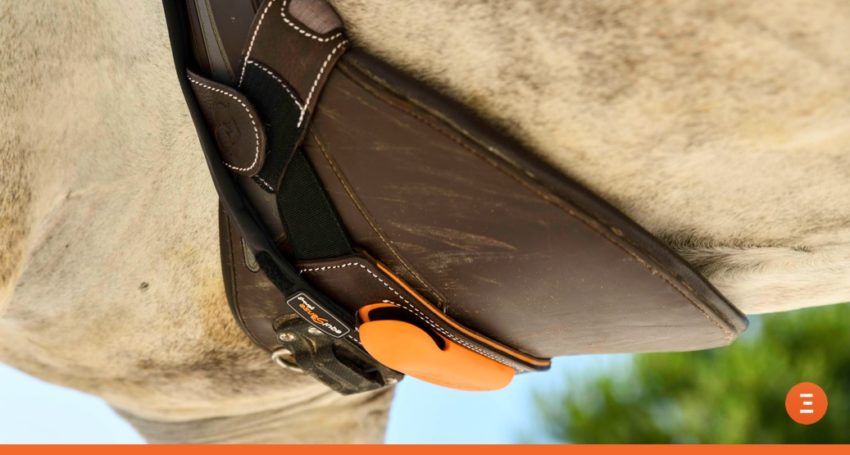
5 Reasons to Use a Heart Rate Monitor with Your Horse
Heart rate monitors for horses have been on the market more and more in recent years. This ability which is very common among human athletes, was until recently, only reserved for top rides or racehorses. With the democratization of measurement tools, this information is becoming more and more accessible to all riders and their horses, no matter their age or level, and this is great news. In this article, we detail 5 benefits of using a heart rate monitor and why you should use it everyday.
Table des matières
- #1- Using a Heart Rate Monitor Allows you to Obtain Information About your Horse’s Health
- #2 – A Heart Rate Monitor is an Essential Tool to See your Horse’s Physical Condition
- #3 – Using the Heart Rate Monitor will Allow you to Set Up an Extremely Precise Training Schedule
- #4 – Cardio Helps Identify your Horse’s Sources of Stress
- #5 – The Heart Rate Monitor is the Only Way to Measure Heart Rate During Exercise
#1- Using a Heart Rate Monitor Allows you to Obtain Information About your Horse’s Health
The heart rate of your horse gives you access to a lot of very important information concerning their health, in particular on their respiratory, movement and of course cardiac levels.
Detection of Respiratory Problems
As explained in a previous article, your horse is more limited in its performance because of its breathing capacities. The fact that, among other things, they cannot breathe through their mouth and that their respiratory rate is mechanically coupled to the frequency of their strides, means that your horse is limited by their lung capacity. Fortunately, their cardiac capacities and physiological adaptations are sufficient to make them an impressive athlete.
📖 TO READ ALSO: 6 ‘MUST KNOW’ ABOUT YOUR HORSE’S RESPIRATORY SYSTEM
Therefore, if your horse has difficulties breathing, they will have to compensate more with their cardiovascular system. As a result, your horse will have a higher than normal heart rate even during “little effort” such as just working on the flat or doing dressage.
By measuring your horse’s heart rate daily during your training sessions, you will be able to, on one hand, ensure that their heart rate is within the norm and on the other hand, you will be able to check that at a standard effort your horse heart rate stays stable.
Lameness Detection
It may be surprising at first, but yes, your horse’s heart rate can detect a movement problem.
As in humans, pain can cause an increased heart rate, this means that if your horse has a movement issue it will also likely cause an increase in their heart rate.
Therefore, by being equipped with a heart rate monitor, you will be able to identify movement problems quickly and effectively.
The Equisense Motion S system also measures both the symmetry of your horse when trotting in a straight line and its heart rate. By combining these two indicators (their current values and their evolution over time), you can easily identify the appearance of lameness and therefore react quickly to heal your horse with the help of health professionals.
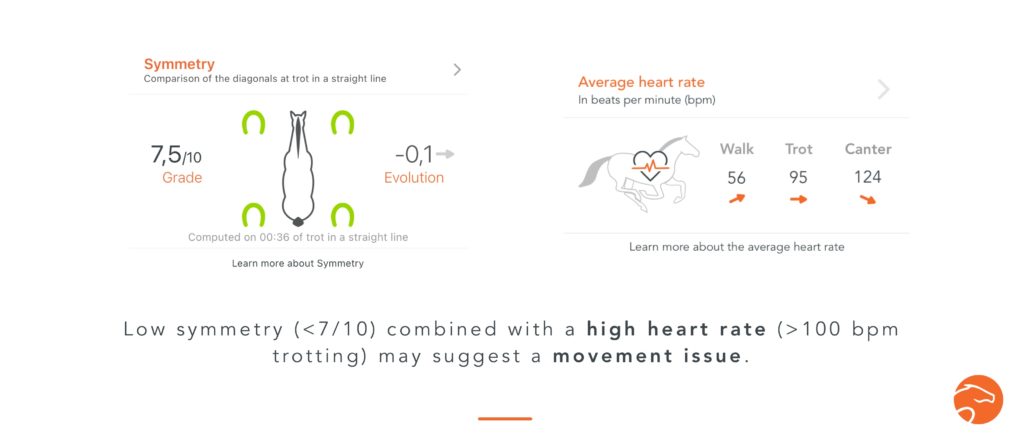
The Detection of Cardiac Arrhythmias
It goes without saying that the use of a heart rate monitor can detect possible cardiac arrhythmias in your horses (abnormalities of the heart rhythm or the shape of the electrocardiogram). Cardiac Arrhythmias is actually quite common in horses. While some are said to be “physiological”, and therefore normal at rest, they should disappear on exertion.
On the same topic 📚 : Arrhythmia in horses: how serious are they?
The use of a heart rate monitor can identify these arrhythmias. Large variations in your horse’s heart rate during light exercise can suggest the presence of arrhythmias. The heart rate monitor becomes particularly interesting when it offers, as does the Equisense Motion S, the possibility of recovering the ECG (electrocardiogram). The precise analysis of the arrhythmia and its frequency of occurrence by a veterinarian then becomes possible.
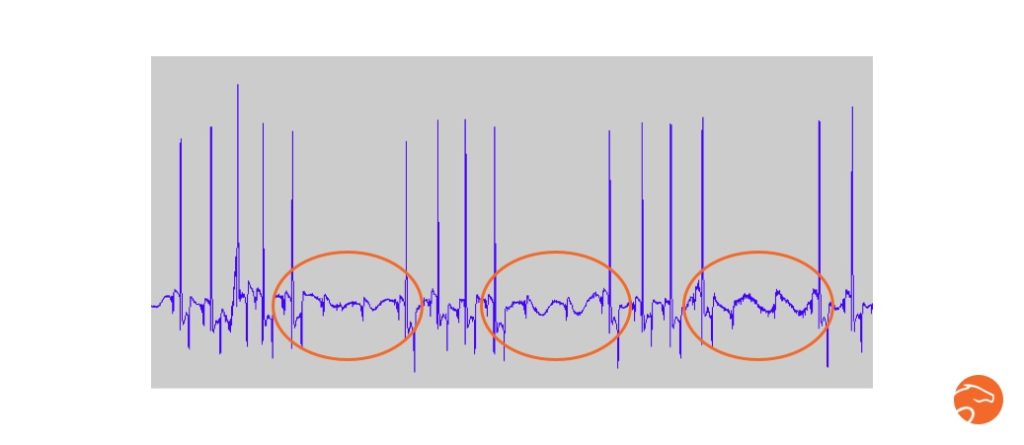
For example, take an atrioventricular block, which is one of the most common arrhythmias in horses. This arrhythmia manifests itself by skipping one or more beats of the normal heart rate rhythm. It can display itself as if the heart is not beating at all, or in an incomplete way.
This is not a problem if your horse is at rest, but it must disappear during exercise, otherwise the physical capacities of your horse will be severely limited.
In the event that your horse exhibits heart rhythm disturbances, it goes without saying that their training should be broadly adapted to not put your horse or yourself in danger. Your veterinarian will be there to guide you on the adaptations to put in place.
In a general sense, when faced with a health concern for your horse, calling a veterinarian should be the first thing you do. Some tools like Equisense Motion S also allow you to share data with other riders or health professionals. It really helps facilitates the diagnosis and also the return to work program.

#2 – A Heart Rate Monitor is an Essential Tool to See your Horse’s Physical Condition
As mentioned above, knowing your horse’s physical condition is essential for the proper management of their training.
Once you know that your horse is able to train, you must then improve their physical fitness. Utilising the heart rate monitor during this process will be an essential tool.
The simple measurement of the heart rate in a step-by-step exercise test, which is extremely easy to perform, allows your horse’s physical condition to be assessed. These tests consist in riding stages of several minutes at increasing cantering speeds, dispersed with rest phases in walking.
Analyzing the heart rate values at each level already makes it possible to assess your horse’s physical condition. In particular by analyzing the V140, the speed at which the horse reaches a heart rate of 140 bpm.
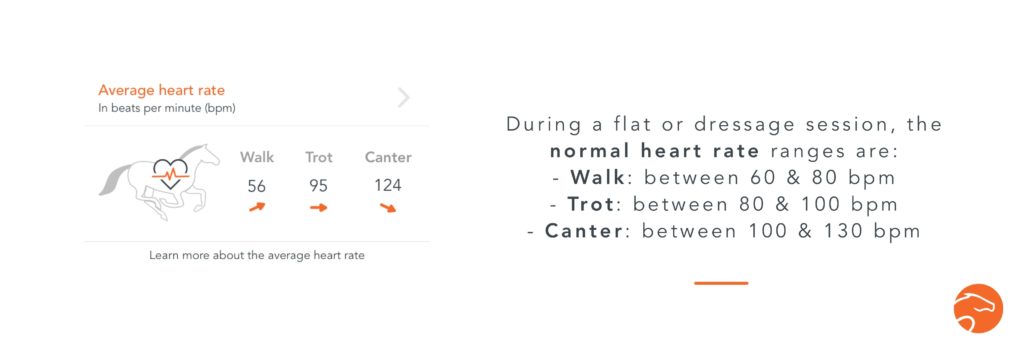
Even outside of a stress test, the simple analysis of the heart rate on a flatwork can give a good overview of the physical condition of your horse.
#3 – Using the Heart Rate Monitor will Allow you to Set Up an Extremely Precise Training Schedule
Once the physical condition of your horse has been assessed, you can then plan their training in according to the level of fitness they are at currently.
With the analysis of the heart rate on an exercise test or simple canter, it is possible to calibrate the canter times and speeds for your next sessions.
For example: for a horse free from health problems but with an insufficiently developed physical condition, we can choose to start by staying on a canter at low speed (350m/min), but gradually increasing the duration.
📖 LEARN MORE: HOW TO SCHEDULE A TRAINING PLAN FOR YOUR HORSE
By taking the almost daily measurements of your horse’s heart rate during exercise you will see that with equal effort, the cardio gradually decreases, a sign that your training is paying off.
Finally, heart rate monitors such as the Equisense Motion S can measure recovery time after exercise. Tracking this value will also help you identify your progress and adjust your training accordingly.
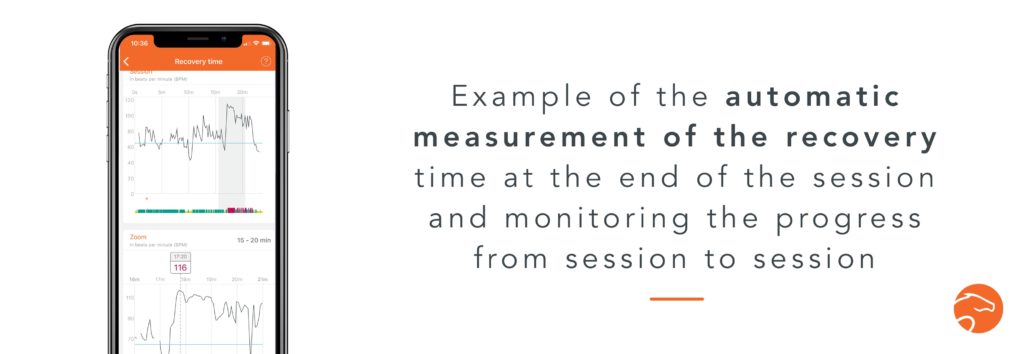
#4 – Cardio Helps Identify your Horse’s Sources of Stress
Even in perfect health and with a good training program, your horse can sometimes be under stress that cannot always be identified.
While acute stress is sometimes quite easy to identify even without a heart rate monitor. When it manifests itself in deviations, for example, chronic stress can be more difficult to identify. Measuring your horse’s heart rate while they are resting is a way to detect it. If your horse’s heart rate is elevated even when they are in the paddock or resting it can indicate chronic stress.
With the Equisense Motion S, you can attach it to your horse and leave them for a few minutes in the stable or yard. Measuring their heart rate at rest and when walking on a long rein, as well as a quick analysis of their attitude, can help you see if your horse is stressed.
Stress reduction is a major issue. In fact, stress has a major impact on your horse’s health, as well as on its learning abilities.
#5 – The Heart Rate Monitor is the Only Way to Measure Heart Rate During Exercise
As you will understand, the heart rate monitor is a complete and very useful tool.
Especially for high level equestrian riders as it is not possible for a rider to feel their horse’s heart rate while training.
Using a tool such as the Equisense Motion S is therefore the only solution to have access to this information.
See you soon in the next article,
Camille Saute
Co-founder of Equisense
Links Used
Galloux, P., & Goupil, X. (2020). L’actualité en matière d’entraînement du cheval de CCE. Equipedia.
Boichot, L. (2020). Utiliser un cardiofréquencemètre pour accompagner la performance. Equipedia.
Colin, C. (2005). L’électrocardiogramme du cheval, intérêt et applications cliniques. Ecole nationale vétérinaire de Lyon.